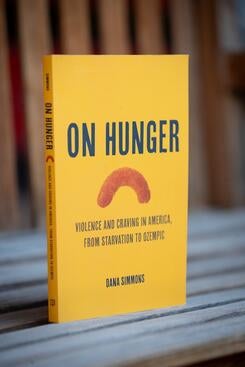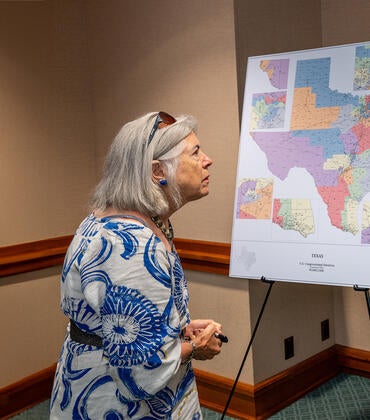
Dana Simmons wants you to know that if you are hungry, it is not your fault.
In her recently released book, “On Hunger: Violence and Craving in America, from Starvation to Ozempic,” published by UC Press, Simmons challenges the idea that hunger is a natural result of scarcity as she explores patterns and systems of manufacturing hunger to manipulate people, especially marginalized groups.
“We tend to react to hunger as if it is there from the depths of time, or that it’s something biologically determined,” said Simmons, an associate professor and chair of UCR’s Department of Society, Environment, and Health Equity. “But that’s a limited view of how hunger works.”
Simmons said that hungry people are often described as bad financial managers, uneducated, or genetically inclined to respond poorly to the modern food environment.
“In fact, if you actually look at the history, hunger is being actively produced and has been actively produced. It’s not some byproduct. It’s not some remainder of the past,” Simmons said. “It’s actively produced by the very forces that are shaping what we think of as progress.”
With expertise as a historian of science and technology as her foundation, Simmons’ research looks at both the violent and covert ways that hunger has been used to control behavior. She also examines how biological and social forces shape hunger and how their influence changes over time.
Simmons begins “On Hunger” by detailing how the U.S. government used hunger against native people in the 19th century. After the mass slaughter of bison, federal officials withheld promised food rations to force compliance — whether to pressure tribal leaders into selling land to white settlers or to assimilate Indigenous children by removing them from their homes and sending them to boarding schools.
She also cites other examples in which hunger was deliberately used as a form of coercion. In the Southern states following emancipation, plantation owners limited access to food to compel formerly enslaved people to work.
Later — before, during, and after the Great Depression—withholding food became a tactic to force workers to migrate when seasonal work ended or to keep them indebted to employers who paid “starvation wages.”
Today, food deprivation and meals designed to leave people hungry are still used in prisons as tools of punishment and behavioral control.
But “On Hunger” also explores the subtler ways hunger is manufactured by food itself and perpetuated by systems driven toward profit. Simmons draws a direct line between the development of foods with high sugar content and the rise of the semaglutide drugs like Ozempic and Wegovy, marketed to treat obesity. In both cases, the hungry body becomes a target, either to sell more food or to sell pharmaceutical solutions designed to suppress appetite.
Simmons reasons that the more people remain hungry, the more food companies and drug makers profit. And it’s big business. She notes that by 2023, Novo Nordisk — the Danish company behind Ozempic and Wegovy — had a market capitalization greater than the entire GDP of Denmark.
Simmons was inspired to study the history of hunger after a survey about food insecurity among UCR students turned up shocking results.
“In 2015, of the students who responded, 62% were food insecure,” Simmons said. Surveys since then show that about half of students are food insecure and half of that number are very food insecure, she said.
At the time of the first survey, Simmons was teaching a class on modern famine that studied events in faraway places. But after seeing survey results, the class began discussing what was happening closer to home. Students discussed their strategies for managing their hunger when they didn’t have enough money to eat.
Simmons was recruited to participate in a Basic Needs working group. As the campus developed resources to support students, she questioned the underlying causes that made it possible that more than 50% of students were not eating due to financial reasons.
“What's the history that has brought us to this point, where on a campus that serves a lot of underrepresented students, half of the students are not eating properly for financial reason?” Simmons asked.
She decided to study the problem further. Another motivation for the book came from research on the history of psychology.
“Hunger is basically at the origin of so much of human sciences that (scientists) are obsessed with studying hunger,” Simmons said. She explained that the first experiments in experimental psychology involved starving kittens, then placing them in a puzzle box and observing how long it took them to figure out how to open a door to find food.
Simmons challenges the “deficiency narratives” that blame people for hunger.
“There is a way in which hunger is produced, and then retroactively explained away as a character defect,” Simmons said. “That’s incredibly harmful.”
Simmons explained that she meets students who have internalized the idea that hunger is their fault, believing they should be able to handle things better.
“It's not your fault,” Simmons said. “If I can lift even just a little bit of that weight, that would make me really happy.”
“On Hunger: Violence and Craving in America, from Starvation to Ozempic” is available through Luminos, University of California Press’s Open Access publishing program.




